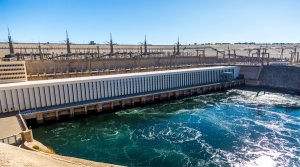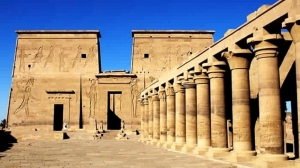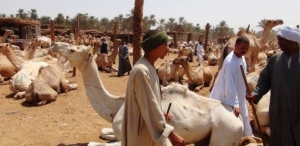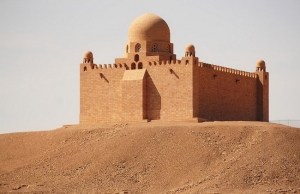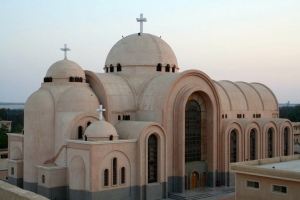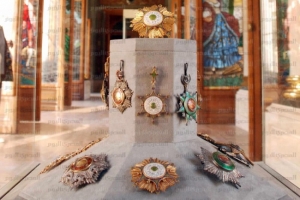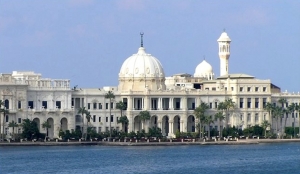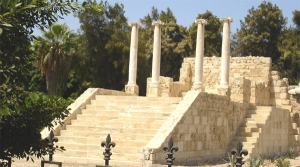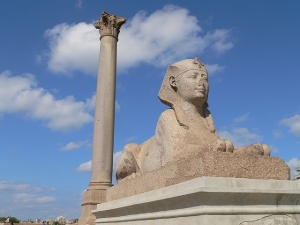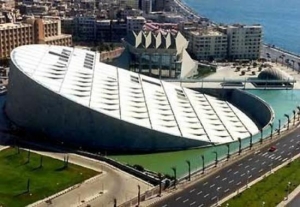+2 0122-345-3028
This email address is being protected from spambots. You need JavaScript enabled to view it.
Super User
High Dam
High Dam
Located near Aswan, the world famous High Dam was an engineering miracle when it was built in the 1960s. It contains 18 times the material used in the Great Pyramid of Cheops.
The Dam is 11,811 feet long, 3215 feet thick at the base and 364 feet tall.
Today it provides irrigation and electricity for the whole of Egypt and, together with the old Aswan Dam built by the British between 1898 and 1902, 6km down river, wonderful views for visitors.
From the top of the two Mile long High Dam you can gaze across Lake Nassar, the huge reservoir created when it was built, to Kalabsha temple in the south and the huge power station to the north.
The High Dam created a 30% increase in the cultivatable land in Egypt, and raised the water table for the Sahara as far away as Algeria.
The electricity producing capability of the Dam doubled Egypt's available supply.
The High Dam added a whole new aspect to Egypt and a new environment as well.
The lake is some 500 miles long and at the time it was built, if not now, was the world's largest artificial lake.
Edfu Temple
Edfu Temple
Dedicated to Horus, the falcon headed god, it was built during the reigns of six Ptolemies. We have a great deal of information about its construction from reliefs on outer areas. It was begun in 237 BC by Ptolemy III Euergetes I and was finished in 57 BC.
This is not only the best preserved ancient temple in Egypt, but the second largest after Karnak. It was believed that the temple was built on the site of the great battle between Horus and Seth.
The main building, which includes a great Hypostyle Hall, was uncovered by Mariette in the 1860s.
There are numerous reliefs, including a depiction of the Feast of the Beautiful Meeting, the annual reunion between Horus and his wife Hathor.
The reliefs are mostly situated on the inside of the first pylon, and spiritually connect this temple with Hathor’s Temple at the Dendera complex.
During the third month of summer, the priests at the Dendera complex would place the statue of Hathor on her barque (a ceremonial barge) and would thus bring the statue to the Edfu Temple, where it was believed that Horus and Hathor shared a conjugal visit.
Each night, the god and goddess would retire to the mamissi, or berthing house.
There is still an entrance colonnade to the mamissi, and reliefs with considerable remaining color just outside the main temple. These images portray the ritual of the birth of Harsomtus, son of Horus and Hathor.
The pylons of the main Temple are about 118 feet high with typical scenes of the pharaoh in battle with his enemies. Within the pylons is the colonnaded courtyard with distinctive, pared columns, which leads into the great hypostyle hall. But on either side of the courtyard there are gates which lead to an area behind the temple and inside the bounding walls.
Here, there are inscriptions recording donations of land which were probably transferred from demotic documents.
There are also dramatic images depicting the defeat of Seth by Horus. There was an annual ritual called the known as the Triumph of Horus (10 harpoons) which ended in the slaying of a hippopotamus, the symbol of Seth.
The facade of the first hypostyle hall has images honoring Horus and Hathor, and there is an immaculate ten foot tall colossi of Horus as the falcon god here (a matching colossi was destroyed). Beyond the great hypostyle hall is a second, smaller hypostyle hall which leads to a well called the Chamber of the Nile where the Priests obtained pure holy water.
Beyond the second hypostyle hall is the offering hall, followed by the vestibule and finally the sanctuary surrounded by chapels of different gods.
There is a granite naos here dedicated by Nectanebo II, making it the oldest relic in the temple. The front chapel has a depiction on the ceiling showing the voyage of the solar barque through the Twelve Hours of the day, with an inspiring image of the goddess, Nut
Darwa
Darwa
The main and really only attraction of this town just south of Kom Ombo is the camel market.
Sometimes up to 2,000 camels are bought to the market, which is usually liveliest on Sundays.
Most of the camels come from the Sudan in caravans up to Abu Simbel, where they are trucked the remainder of the way.
Agha Khan
Mausoleum of the Aga Khan
This is the Mausoleum of the spiritual leader of the Ismailis, a Shi'ite sect (as were the Fatimid) based principally in India but with followers around the world. It is a very elegant pink granite structure of late 1950 origin, which also resembles the Fatimid tombs in Cairo.
Members of this sect consider themselves to be the direct spiritual descendants of the Fatimid. The Mausoleum has an excellent view, including Aga Khan's white villa below, and is near the Monastery of St. Simeon on the west bank at Aswan. His wife still lives in the villa three months of the year.
The Aga Khan was extremely wealthy. On his birthday in 1945, he was weighed in diamonds which he then distributed to his followers. It should be noted, also, that he was a large man. Every day that his widow was at the Villa, she places a Red Rose on his white Carrara marble tomb.
His widow, Omme Habibeh, popularly referred to as "The Begum" died on July 1st, 2000. The other months, a gardener fills this function, and it has been rumored that at one point, not a single rose could be found in Egypt, so for almost a week, roses were flown in from Paris by private jet.
Mohammed Shah Aga Khan was educated in Europe and succeeded his father in 1885 to become the 48th imam. He was succeeded by his grandson, Karamu AgGa Khan upon his death in 1957. The Mausoleum is no longer open to the public.
Wadi El Natroun
Wadi El Natroun
The quasi-oasis of Wadi Natroun, just off the Desert Road between Cairo and Alexandria, takes its name -and oasis nature- from deposits of natron salts, the main ingredient in ancient mummifications
The four Wadi Natroun monasteries have all been totally ruined and rebuilt at least once since their foundation during the fourth century. Each has a high wall surrounding one or more churches, a central keep entered via a drawbridge, containing a bakery, storerooms and wells enabling the monks to withstand siege, and diverse associated chapels
Their fortified exteriors, necessary in centuries past to resist Bedouin raiders, cloak what are today very forward-looking, purposeful monastic establishments.
Deir Anba Bishoi :
Deir Anba Bishoi is the most accessible monastery only 10km from the highway. It contains five churches, the oldest of which is St. Bishoi’s which features three “haikals” sanctuaries dating from the fourth, ninth and tenth centuries. There’s also a fifth-century well where Berber tribesmen washed their swords after massacring the 49 Martyrs of the monastery of St. Makerinus. The multi-domed building furthest away from the entrance is the residence of Pope Shenouda III, the current Coptic Pope. Most of the Coptic popes have been chosen from the monks of Wadi Natroun and Deir Anba Bishoi in particular.
Deir Al-Suryani :
Deir Al-Suryani was named after a group of Syrian monks who used to live there. Its principal church of the Virgin was built around 980 and contains a sanctuary with stucco ornamentation and a superb ebony “Door of Prophecies” inlaid with ivory panels depicting the disciples and the seven epochs of the Christian era. dark passage-way at the back of the church leads to the cave where Bishoi tied his hair to a chain hanging from the ceiling to prevent himself sleeping for four days until a vision of Christ appeared. he monastery has a modern library in which the monastery’s antique volumes are lovingly maintained.
Deir El-Baramus :
Deir El-Baramus lies 4 km north to Deir Anba Bishoi. This monastery was found by St. Makarius in 340making it the oldest of the four moanstries of Wadi Natroun. Its Name “Monastery of the Romans” honours Maximus and Domidus , two sons of the Roman Emperor Valentinus who died from excessive fasting. Their bodies were buried in a crypt below the Church of the Virgin. Restoration works have revealed layers of medieval frescoes in the nave, the western end of which incorporates a fourth-century pillar with Syriac inscriptions. The ninth-century church shares a vine-laden courtyard with a keep and four other churches.
Deir Abu Maqar :
Deir Abu Maqar is the oldest and the furthest of the monasteries founded by St Makarius who died in 390. It lies 18km southwest of St. Bishoi. It is enclosed by a circular wall ten meters high. In times past, two giant millstones stood ready to be rolled across to buttress the door against Beduin raiders. Since its nadir in 1969, when only six monks lived here, the monastery has acquired a hundred brethren, a modern printing press and a farm employing 600 workers. The monks have also mastered pinpoint irrigation systems and bovine embryo transplant technology
Royale Jewelry museum Alexandria
Royale Jewelry museum Alexandria
one of the largest museum in Egypt which is Royal Jewelry Museum, be witness to the collections of Crystal, gold and diamond artifacts, that date back to different families whom ruled Egypt, some of them was gifts from kings of France, Britain and the others was special made, Housed in an exquisitely decorated villa that formerly belonged to king Farouk’s first wife, the museum is a true gem, offering on display a great collection of glitzy artifacts that belonged to the excessive and extravagant Egyptian monarch and his family.
The Royal Jewelry Museum contains 11 thousand artifacts, most popular of them is 12 cups made of bronze and gold for Prince Tewfik, moreover feel ravishing with the twinkling stones and diamonds lobes, treat yourself to be pampered while explore money bags made of leather and add to it gold and precious stones lobes, Moreover, the priceless collection of Prince Mohamed Ali Tewfik has the marvelous Sultan pocket watch that was made out of pure gold and precious stones and a number of glass cups that are decorated with 977 lobes of diamonds.
Ras El Teen Palace
Ras El- Tin Palace
was founded by Muhammad Ali Pasha ( 1805- 1848 ) on the coast of the Mediterranean Sea in Alexandria, Ras El- Tin Palace has imaginable historical breadth along Egyptian Royalty, it took 11 years to be established and was officially opened in 1847, This palace witnessed the fall of the monarchy in Egypt, King Farouk left Egypt in 1952 from the palace`s harbor, El Mahrousa, heading Italy, it was built on a foundation of 17,000 square, and 12 acres Fig Trees Gardens, Through the reign of successive kings the complex was used as their residence and the government headquarters during the summer season.
Ras El-Tin Palace location is very fascinating on Mediterranean Sea, King Farouk rebuilt the palace on the modern style, he established a marine pool which connect between the Palace with the sea, The palace consists of a bedroom, kitchen and some additional rooms, The palace also includes the hall of the throne with two annexed salons, a dining room, a hall for major feasts, a ministers` hall, a vast, spectacular salon which oversees the harbor of El Mahrousa, the king`s private suite and bathroom.
Ras el Soda Temple
Ras el Soda Temple is one of the finest temples in Egypt, it consists of a wide staircase, 5 columns but there is one column lies at Greco roman museum, and much of cella walls were will standing, It was situated in Ras El Soda area on the agricultural road leading to El Montazah and Abu Qear and near the eastern company of Linen. In the early 19th and 20th centuries, this temple was transported to Bab Sharq, The process of rebuilding the Temple took six months, but the remaining part now isn’t a temple but a small structure.
Ras el Soda Temple consists of 2 floors, and 4 columns, first column dedicated to Hermanubis who is depicted as a young man wearing a Greek tunic with a torch in his hand, and next to his feet there is a seated figure of Jackal, second one dedicated to god Harpo-cratis who is depicted as a naked child with his thumb in his mouth, he is also shown with a side lock of hair, third one dedicated to goddess Isis who is depicted in the Greek form as a standing figure of a woman wearing a tunic with a knot on her dress, she is also crowned with two horns and a sun disk, and she holds the situla (jar for sacred water), last column or god Osiris in canopic form, he is represented as a jar and its lid takes the shape of the head of god Osiris.
pompeys pillar
pompeys pillar
is the biggest memorial column in Egypt, The Pompey`s pillar is located within the zone of the Serapeum of Alexandria, It is an approximately 25m granite column with a circumference of 9m that was constructed in honor of the Emperor Diocletian, On the upper part of the base, are some Greek inscriptions which says :(To the most just Emperor, tutelary of Alexandria, Diocletian, the invincible Postumas, the perfect of Egypt, has erected this monument).
Amuse yourself with the fascinating parts of this site which contains galleries where sacred Apis bulls were buried, and three sphinxes, the column must have been erected after 292 A.D., in honor of the Roman emperor. A serious revolution has broken out in Alexandria; Diocletian ordered the city to be besieged till it fell after 8 months of resistance.
Library of Alexandria
Library of Alexandria
The most famous among all ancient and medieval libraries was the Library of Alexandria. Not only was it the largest in all antiquity, but also it was associated with scientific research and was frequented by scholars from all over the Mediterranean. Even after its disappearance since 1600 years ago, it continues to survive in the memory of all scholars to this day.
The ancient Library of Alexandria was an amazing intellectual adventure that promoted knowledge and openness to the other and for seven centuries was a beacon of learning and science.
The new Library of Alexandria is a truly very beautiful building. It is located on a superb site on the historic eastern harbor of Alexandria, almost exactly where the old library and the royal palace of the Ptolemies once stood. The complex comprises three main elements: the pre-existing conference center, the new planetarium and the new building. They are all connected underground below the plaza into one large functional complex.
The Library consists of:
- The Main Library (It is a Universal Library designed to serve the public and researchers. The Library collection is displayed over 7 levels from the Roots of Knowledge to the New Technologies.
- The Taha Hussein Library (It is a facility to open doors to the blind and visually impaired. All that appears on a computer screen can be read in Braille or heard using a special program.
- The Young People Library
- The Children Library
- The Multimedia Library.
- The Microfilm Reading Room.
- The Manuscripts Reading Room.
- The Rare Books Reading Room.
